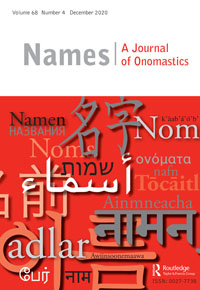Women’s Marital Surname Change by Bride’s Age and Jurisdiction of Residence: A Replication
Published 2020-10-01 — Updated on 2023-02-01
Keywords
- ethnonym,
- race,
- USA,
- anthroponym,
- US Census
- Civil Rights,
- Black Lives Matter ...More
Copyright (c) 2020 American Name Society

This work is licensed under a Creative Commons Attribution 4.0 International License.
Abstract
Hyphenating or keeping premarital surname for all U.S. destination brides marrying in Hawai’i in 2010 was highly, positively correlated with a state-level women’s income measure (r = .78, p < .000) and the analogous statistic for men (r = .64, p < .000), by bride’s state of residence. The women’s measure, only, remained significant when both predictors were used, together, to predict retention/hyphenation (i.e., under regression of both predictors). The interaction of state Gini coefficient and the women’s income measure was positively predictive in a regression including the interaction components as predictors (adjusted-R2 = .66). None of several other predictors suggested by previous research or related to Gini index or income, testable using available, state-level data, were predictive (under regression) alongside the women’s income measure. The older the bride, from any jurisdiction, the more likely she is to hyphenate or keep her surname (?2 for linear trend = 1754.65, p < .000). These analyses comprise a nearly direct replication of previous work, adding novel analyses. Taken together, the original and replicated study may show evidence consistent with a general practice of women taking into account local economic factors, in marital surname decision-making.
References
- Blake, Khandis R., Brock Bastian, Thomas F. Denson, Pauline Grosjean, and Robert C. Brooks. 2018. “Income Inequality not Gender Inequality Positively Covaries with Female Sexualization on Social Media.” Proceedings of the National Academy of Sciences 115, no. 35: 8722–8727.
- Cain Miller, Claire. “The Motherhood Penalty vs. The Fatherhood bonus.” The New York Times. September 6, 2014. Accessed October 23, 2019. https://www.nytimes.com/2014/09/07/upshot/a-child-helps-your-career-if-youre-a-man.html
- Cherlin, Andrew. 1978. “Hereditary Hyphens?” Psychology Today, December, 150.
- Ferguson, Christopher J. 2009. “An Effect Size Primer: A Guide for Clinicians and Researchers.” Professional Psychology: Research and Practice 40, no. 5: 532–538.
- Field, Andy. 2005. Discovering Statistics Using SPSS (2nd ed.). London: Sage.
- Fincher, Corey L., and Randy Thornhill. 2012. “Parasite-Stress Promotes in-Group Assortative Sociality: The Cases of Strong Family Ties and Heightened Religiosity.” Behavioral and Brain Sciences 35, no. 2: 61–119.
- Furstenberg, Frank F., and Karen G. Talvitie. 1980. “Children’s Names and Paternal Claims.” Journal of Family Issues 1, no. 1: 31–57.
- Geary, David C. 2000. “Evolution and Proximate Expression of Human Paternal Investment.” Psychological Bulletin 126, no. 1: 55–77.
- Gini, Corrado. 1909. “Concentration and Dependency Ratios’.” (in Italian). English translation in Rivista di Politica Economica
- , no. 87: 769–789.
- Goldin, Claudia, and Maria Shim. 2004. “Making a Name: Women’s Surnames at Marriage and Beyond.” Journal of Economic Perspectives 18, no. 2: 143–160.
- Hoffnung, Michele. 2006. “What’s in a Name? Marital Name Choice Revisited.” Sex Roles 55, nos. 11-12: 817–825.
- Johnson, David R., and Laurie K. Scheuble. 1995. “Women’s Marital Naming in Two Generations: A National Study.” Journal of Marriage and the Family 57, no. 3: 724–732.
- Johnson, David R., and Laurie K. Scheuble. 2002. “What Should We Call Our Kids? Choosing Children's Surnames when Parents’ Last names differ.” The Social Science Journals 39, no. 3: 419–429.
- Kruger, Daniel J. 2010. “Socio-Demographic Factors Intensifying Male Mating Competition Exacerbate Male Mortality Rates.” Evolutionary Psychology 8, no. 2: 194–204.
- Lockwood, Penelope, Caitlin Burton, and Katelyn Boersma. 2011. “Tampering with Tradition: Rationales concerning Women’s Married Names and Children’s Surnames.” Sex Roles 65, no. 11-12: 827–839.
- MacEacheron, Melanie. 2011. “Hawaii Data: Women’s Marital Surname Change by Bride’s Age and Jurisdiction of Residence.” Names 59, no. 1: 4–11.
- MacEacheron, Melanie. 2016. “North American Women’s Marital Surname Change: Practices, Law, and Patrilineal Descent Reckoning.” Evolutionary Psychological Science 2, no. 2: 149–161.
- Newport, Frank. More States ‘Competitive’ in Terms of Party Identification. Gallup. July 26, 2010. Accessed March 15, 2013. http://www.gallup.com/poll/141548/states-competitive-terms-party-identification.aspx
- Noack, Turid, and Kenneth Aarskaug Wiik. 2008. “Women’s Choice of Surname upon Marriage in Norway.” Journal of Marriage and Family 70, no. 2: 507–518.
- Robnett, Rachael D., and Campbell Leaper. 2013. “Girls Don’t Propose! Ew.’: A Mixed-Methods Examination of Marriage Tradition Preferences and Benevolent Sexism in Emerging Adults.” Journal of Adolescent Research 28, no. 1: 96–121.
- Ruggles, Steven, Trent Alexander, Katie Genadek, Ronald Goeken, Matthew B. Schroeder, and Matthew Sobek. “General Design of Integrated Public Use Microdata Series.” Version 5.0 [Machine-readable database]. Minneapolis. University of Minnesota, 2010.
- Scheuble, Laurie, and David R. Johnson. 1993. “Marital Name Change: Plans and Attitudes of College Students.” Journal of Marriage and the Family 55, no. 3: 747–754.
- Scheuble, Laurie, and David R. Johnson. 2005. “Married Women's Situational Use of Last Names: An Empirical Study.” Sex Roles 53, no. 1–2: 143–151.
- Stafford, Laura, and Susan L. Kline. 1996. “Women’s Surnames and Titles: Men’s and Women’s Views.” Communication Research Reports 13, no. 2: 214–224.
- Suter, Elizabeth A. 2004. “Tradition Never Goes out of Style: The Role of Tradition in Women’s Naming Practices.” The Communication Review 7, no. 1: 57–87.
- U.S. Census Bureau. 2016. “The Majority of Children Live With Two Parents, Census Bureau Reports.” Accessed February 3, 2020 https://www.census.gov/newsroom/press-releases/2016/cb16-192.html#
- U.S. Census Bureau. 2018. “44 Percent of Custodial Parents Receive the Full Amount of Child Support.” Accessed February 3, 2020. https://www.census.gov/newsroom/press-releases/2018/cb18-tps03.html
- U.S. Bureau of Labor Statistics. 2012. “Highlights of Women's Earnings in 2011, October 2012, Report 1038”. Accessed March 13, 2013. http://www.bls.gov/cps/cpswom2011.pdf
- Vandello, Joseph A., and Dov Cohen. 1999. “Patterns of Individualism and Collectivism across the United States.” Journal of Personality and Social Psychology 77, no. 2: 279–292.
- Wildsmith, Elizabeth, Jennifer Manlove, and Elizabeth Cook. 2018, August 8. “Dramatic Increase in the Proportion of Births Outside of Marriage in the United States from 1990 to 2016”. Child Trends. August 8, 2018. Accessed October 23, 2019. https://www.childtrends.org/publications/dramatic-increase-in-percentage-of-births-outside-marriage-among-whites-hispanics-and-women-with-higher-education-levels#targetText+Among%20the%20most%20notable%20changes,(Child%20Trends%2C%202016).

